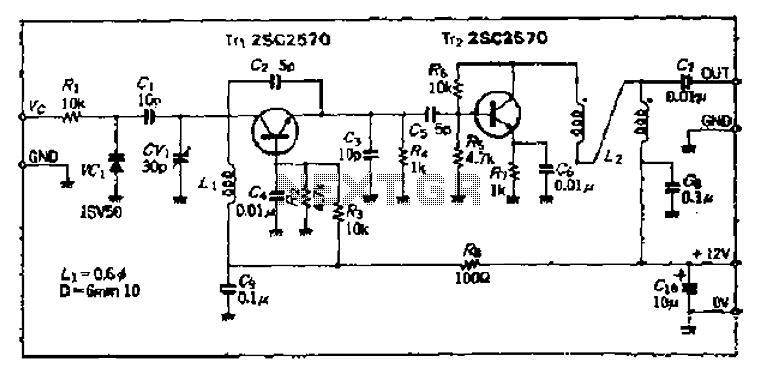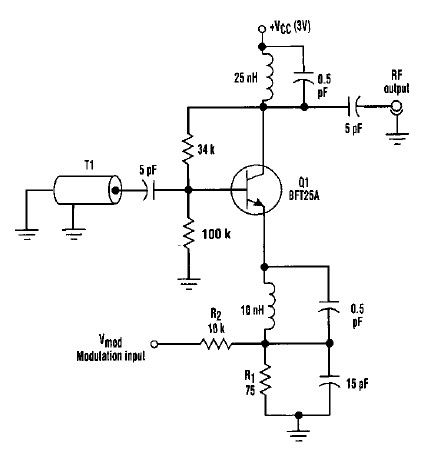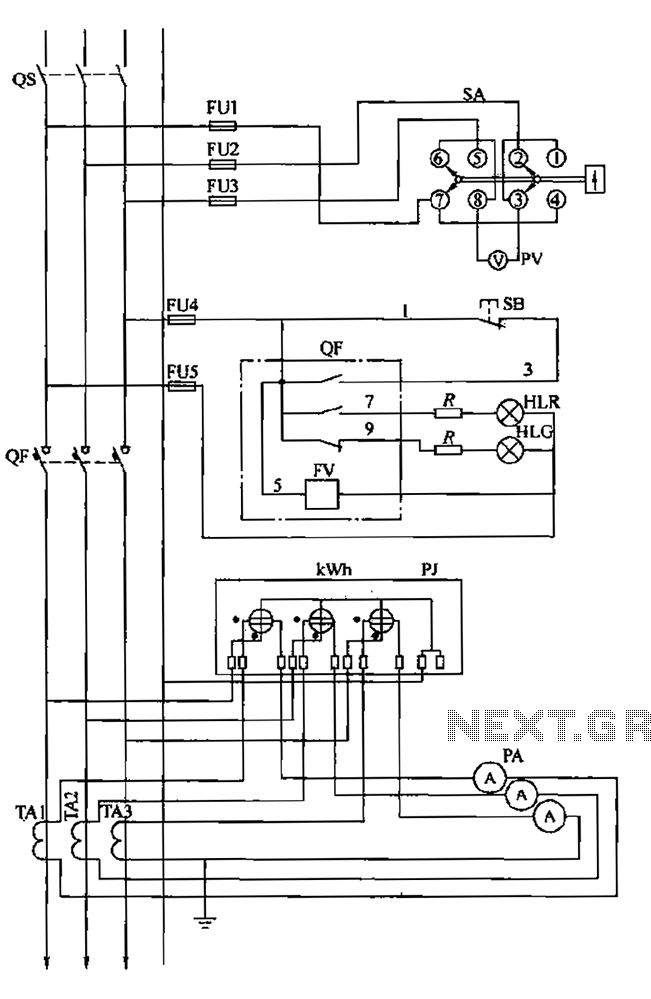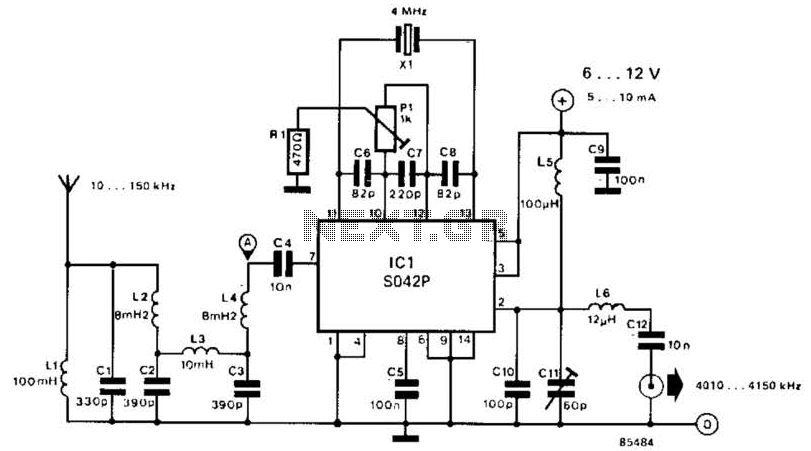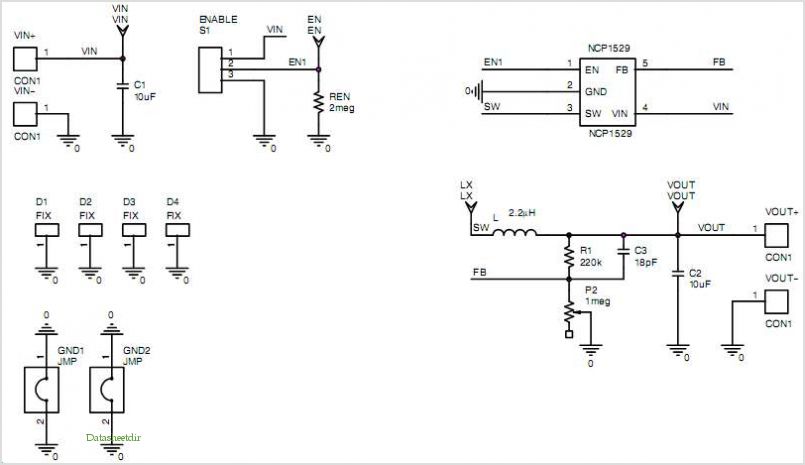
LM331 Frequency to Voltage Converter
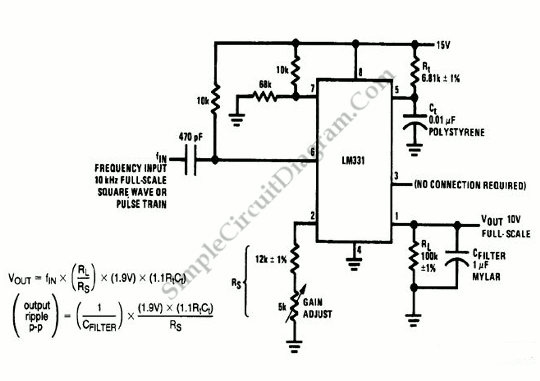
The frequency-to-voltage converter circuit depicted in the schematic diagram produces a 10 V output for a 10 kHz full-scale input (square waves or pulses). The simplicity of the circuit does not compromise its performance, achieving a linearity of approximately 0.06% at full scale. It is important to note that there is a trade-off between ripple and response time. With a filter capacitor (Cfilter) of 1 µF, the output ripple is about 13 mV with a settling time of 0.6 seconds. Reducing Cfilter will result in a quicker response time at the expense of increased ripple, while increasing Cfilter will yield the opposite effect. The 5 kΩ gain adjustment should be set for a 10 V output with a 10 kHz input for calibration. This circuit can accept positive, negative, or differential control voltages, and when the control voltage is zero, the output frequency is also zero. The 741 operational amplifier serves as a current source to charge the timing capacitor (C1) linearly. The voltage-to-frequency converter (VFC) circuit consists of a uni-junction transistor (UJT) oscillator, where the timing charge capacitor (C2) is linearly dependent on the input signal voltage. The voltage across resistor (R5) regulates the charging process. The VFC circuit employs a 555 integrated circuit as its core component, operating with supply voltages of +5V and -5V, and the input is limited to a range of 0-2V. This circuit can boost a low voltage battery to 5V, requiring only a 1.5V input to achieve a 5V output at 40 mA. With a 2.4V input, it can supply 180 mA. Additionally, the TMP01 temperature-to-frequency converter circuit exemplifies another common method of transmitting analog information by converting voltage to the frequency domain. This circuit utilizes monolithic voltage-to-frequency converters (VFCs), which offer advantages such as low cost, robustness, and an open-collector output configuration.
The frequency-to-voltage converter circuit is designed to transform frequency signals into a proportional voltage output, making it useful in various applications such as signal processing and measurement systems. The circuit's architecture includes a combination of operational amplifiers, resistors, capacitors, and transistors, which work together to ensure accurate conversion and stable output.
The use of the 741 operational amplifier as a current source allows for precise control over the charging of the timing capacitor (C1), which is critical for maintaining linearity and minimizing distortion in the output signal. The choice of components, including the uni-junction transistor (UJT) and the 555 timer IC, further enhances the circuit's performance by providing stable oscillation and reliable voltage regulation.
In terms of power supply requirements, the circuit operates effectively with dual supply voltages of +5V and -5V, ensuring compatibility with a wide range of input signal levels. The limitation of the input voltage to 0-2V allows for safe operation while still providing adequate output levels for most applications. The ability to adjust gain via a 5 kΩ potentiometer enables users to calibrate the output voltage to match specific requirements, making the circuit versatile for different use cases.
Furthermore, the TMP01 temperature-to-frequency converter showcases the circuit's applicability in temperature sensing and monitoring systems, where analog temperature readings can be transmitted as frequency signals for further processing. The integration of monolithic VFCs in this design not only simplifies the circuit but also enhances reliability and reduces the overall footprint, making it suitable for compact electronic devices.
Overall, this frequency-to-voltage converter circuit exemplifies a well-engineered solution for converting frequency signals into voltage outputs, with a focus on performance, stability, and adaptability across various electronic applications.The frequency to voltage converter circuit illustrated in the schematic diagram below produces a 10 V output for 10 kHz full scale input (square waves or pulses). The simplicity of the circuit doesn`t mean a bad performance: this circuit has linearity about 0. 06% at full scale. For your note, there is a trade-off between ripple versus response tim e. With Cfilter at 1uF, the output ripple is about 13 mV with 0. 6 s settling time. The response time will be quicker if Cfilter is decreased in the expense of increased ripple by the same factor. An increase in Cfilter produces the opposite results. Set the 5Kohm gain adjust for 10 V out with a 10 kHz input to trim. Using this circuit, we can accept positive or negative or differential control voltages. When the control voltage is zero, the output frequency is zero. To charge the timing capacitor C1 linearly, the 741 op amp forms a current source controlled Continue reading †’.
The following voltage to frequency converter (V/FC VCO) circuit consist of a UJT (uni-junction transistor) oscillator in which the timing charge capacitor C2 is linearly depends on the input signal voltage. The voltage across resistor R5 set the charging Continue reading †’. Voltage-to-frequency converter (VFC) circuit is shown in the schematic diagram below. The circuit employs 555 IC as the core of its function. This circuit uses +5V and -5V supply voltages, and the input is limited to 0-2V. You can adjust Continue reading †’. Using this circuit a low voltage battery can be increased to 5V. The need of input voltage of this circuit is only 1. 5V and the output voltage is 5V at 40mA. Using 2. 4V input, this circuit can supply 180mA at Continue reading †’. This is a TMP01 Temperature-to-Frequency Converter circuit. Converting voltage to the frequency domain is another common method of transmitting analog information.
This circuit uses monolithic voltage-to-frequency converters (VFCs) that has some advantages like low cost a robust, and has open-collector Continue reading †’. 🔗 External reference
The frequency-to-voltage converter circuit is designed to transform frequency signals into a proportional voltage output, making it useful in various applications such as signal processing and measurement systems. The circuit's architecture includes a combination of operational amplifiers, resistors, capacitors, and transistors, which work together to ensure accurate conversion and stable output.
The use of the 741 operational amplifier as a current source allows for precise control over the charging of the timing capacitor (C1), which is critical for maintaining linearity and minimizing distortion in the output signal. The choice of components, including the uni-junction transistor (UJT) and the 555 timer IC, further enhances the circuit's performance by providing stable oscillation and reliable voltage regulation.
In terms of power supply requirements, the circuit operates effectively with dual supply voltages of +5V and -5V, ensuring compatibility with a wide range of input signal levels. The limitation of the input voltage to 0-2V allows for safe operation while still providing adequate output levels for most applications. The ability to adjust gain via a 5 kΩ potentiometer enables users to calibrate the output voltage to match specific requirements, making the circuit versatile for different use cases.
Furthermore, the TMP01 temperature-to-frequency converter showcases the circuit's applicability in temperature sensing and monitoring systems, where analog temperature readings can be transmitted as frequency signals for further processing. The integration of monolithic VFCs in this design not only simplifies the circuit but also enhances reliability and reduces the overall footprint, making it suitable for compact electronic devices.
Overall, this frequency-to-voltage converter circuit exemplifies a well-engineered solution for converting frequency signals into voltage outputs, with a focus on performance, stability, and adaptability across various electronic applications.The frequency to voltage converter circuit illustrated in the schematic diagram below produces a 10 V output for 10 kHz full scale input (square waves or pulses). The simplicity of the circuit doesn`t mean a bad performance: this circuit has linearity about 0. 06% at full scale. For your note, there is a trade-off between ripple versus response tim e. With Cfilter at 1uF, the output ripple is about 13 mV with 0. 6 s settling time. The response time will be quicker if Cfilter is decreased in the expense of increased ripple by the same factor. An increase in Cfilter produces the opposite results. Set the 5Kohm gain adjust for 10 V out with a 10 kHz input to trim. Using this circuit, we can accept positive or negative or differential control voltages. When the control voltage is zero, the output frequency is zero. To charge the timing capacitor C1 linearly, the 741 op amp forms a current source controlled Continue reading †’.
The following voltage to frequency converter (V/FC VCO) circuit consist of a UJT (uni-junction transistor) oscillator in which the timing charge capacitor C2 is linearly depends on the input signal voltage. The voltage across resistor R5 set the charging Continue reading †’. Voltage-to-frequency converter (VFC) circuit is shown in the schematic diagram below. The circuit employs 555 IC as the core of its function. This circuit uses +5V and -5V supply voltages, and the input is limited to 0-2V. You can adjust Continue reading †’. Using this circuit a low voltage battery can be increased to 5V. The need of input voltage of this circuit is only 1. 5V and the output voltage is 5V at 40mA. Using 2. 4V input, this circuit can supply 180mA at Continue reading †’. This is a TMP01 Temperature-to-Frequency Converter circuit. Converting voltage to the frequency domain is another common method of transmitting analog information.
This circuit uses monolithic voltage-to-frequency converters (VFCs) that has some advantages like low cost a robust, and has open-collector Continue reading †’. 🔗 External reference
